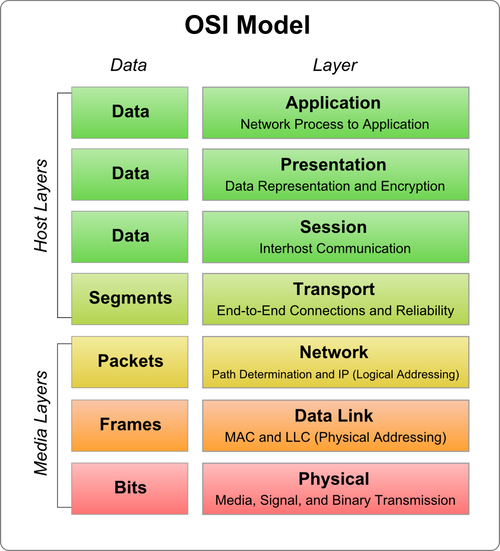Layer | Function | Protocols | Network Components |
| Application User Interface | - used for applications specifically written to run over the network
- allows access to network services that support applications;
- directly represents the services that directly support user applications
- handles network access, flow control and error recovery
- Example apps are file transfer,e-mail, NetBIOS-based applications
| DNS; FTP; TFTP; BOOTP; SNMP;RLOGIN; SMTP; MIME; NFS; FINGER; TELNET; NCP; APPC; AFP; SMB | Gateway |
| Presentation Translation | - Translates from application to network format and vice-versa
- all different formats from all sources are made into a common uniform format that the rest of the OSI model can understand
- responsible for protocol conversion, character conversion,data encryption / decryption, expanding graphics commands, data compression
- sets standards for different systems to provide seamless communication from multiple protocol stacks
- not always implemented in a network protocol
| Gateway Redirector |
| Session 'syncs and sessions' | - establishes, maintains and ends sessions across the network
- responsible for name recognition (identification) so only the designated parties can participate in the session
- provides synchronization services by planning check points in the data stream => if session fails, only data after the most recent checkpoint need be transmitted
- manages who can transmit data at a certain time and for how long
- Examples are interactive login and file transfer connections, the session would connect and re-connect if there was an interruption; recognize names in sessions and register names in history
| NetBIOS Names Pipes Mail Slots RPC | Gateway |
Transport packets; flow control & error-handling | - additional connection below the session layer
- manages the flow control of data between parties across the network
- divides streams of data into chunks or packets; the transport layer of the receiving computer reassembles the message from packets
- 'train' is a good analogy => the data is divided into identical units
- provides error-checking to guarantee error-free data delivery, with on losses or duplications
- provides acknowledgment of successful transmissions; requests retransmission if some packets don’t arrive error-free
- provides flow control and error-handling
| TCP, ARP, RARP; SPX NWLink NetBIOS / NetBEUI ATP | Gateway Advanced Cable Tester Brouter |
Network addressing; routing | - translates logical network address and names to their physical address (e.g. computername > MAC address)
- responsible for
- addressing
- determining routes for sending
- managing network problems such as packet switching, data congestion and routing
- if router can’t send data frame as large as the source computer sends, the network layer compensates by breaking the data into smaller units. At the receiving end, the network layer reassembles the data
- think of this layer stamping the addresses on each train car
| IP; ARP; RARP, ICMP; RIP; OSFP; IGMP; IPX NWLink NetBEUI OSI DDP DECnet | Brouter Router Frame Relay Device ATM Switch Advanced Cable Tester |
Data Link data frames to bits | - turns packets into raw bits 100101 and at the receiving end turns bits into packets.
- handles data frames between the Network and Physical layers
- the receiving end packages raw data from the Physical layer into data frames for delivery to the Network layer
- responsible for error-free transfer of frames to other computer via the Physical Layer
- this layer defines the methods used to transmit and receive data on the network. It consists of the wiring, the devices use to connect the NIC to the wiring, the signaling involved to transmit / receive data and the ability to detect signaling errors on the network media
| Logical Link Control- error correction and flow control
- manages link control and defines SAPs
802.1 OSI Model 802.2 Logical Link Control | Bridge Switch ISDN Router Intelligent Hub NIC Advanced Cable Tester |
Media Access Control- communicates with the adapter card
- controls the type of media being used:
802.3 CSMA/CD (Ethernet) 802.4 Token Bus (ARCnet) 802.5 Token Ring 802.12 Demand Priority |
Physical hardware; raw bit stream | - transmits raw bit stream over physical cable
- defines cables, cards, and physical aspects
- defines NIC attachments to hardware, how cable is attached to NIC
- defines techniques to transfer bit stream to cable
| IEEE 802 IEEE 802.2 ISO 2110 ISDN | Repeater Multiplexer Hubs TDR Oscilloscope Amplifier |
